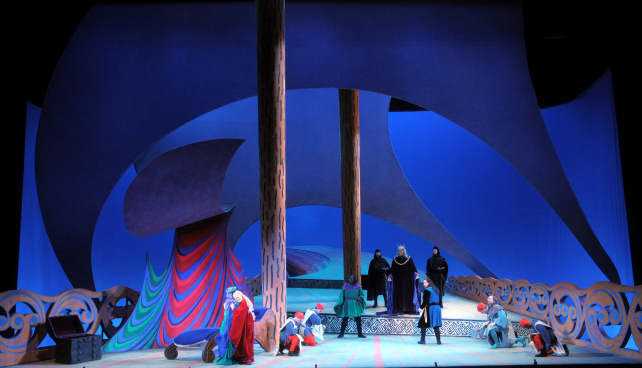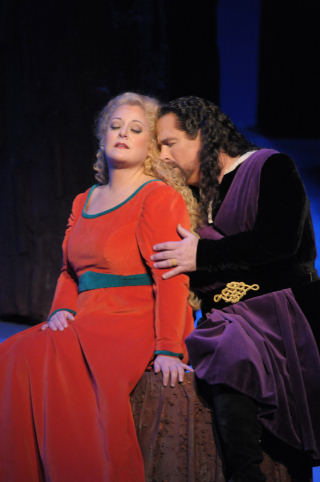Other Links
Editorial Board
-
Editor - Bill Kenny
-
Deputy Editor - Bob Briggs
Founder - Len Mullenger
Google Site Search
SEEN
AND HEARD INTERNATIONAL OPERA REVIEW
Wagner, Tristan und Isolde: Soloists, Chorus and Orchestra of Lyric Opera of Chicago, Sir Andrew Davis (conductor) Lyric Opera Center Chicago 31.1.2009 (JLZ)
Production:
Director: José María Condemi
Stage, Set and Costume Design: David Hockney
Lighting - Duane Schuler
Chorus Master - Donald Nally
Conductor: Sir Andrew Davis
Cast:
Isolde: Deborah Voigt
Tristan: Clifton Forbis
Brangäne: Petra Lang
Kurwenal: Jason Stearns (Jan. 27-Feb. 8; Greer Grimsley, Feb. 12-28)
Marke: Stephen Milling
Melot: Daniel Billings
Since its premiere in 1865, Richard Wagner's signal work of musical
modernism, Tristan und Isolde, remains a truly powerful
opera, and this recent production by Lyric Opera of Chicago was
exceptionally moving. With its fine international cast, an
experienced conductor and orchestra, and an effective production by
David Hockney, the combined elements produced a fine synergy;
invoking the cliché, that this was as near to Gesamtkunstwerk
as one might hope to experience anywhere.
Clifton Forbis
was a strong and persuasive Tristan, as easy in his role as Voigt
was in hers. Forbis gave a welcome physicality to the role from the
start, responding dramatically to the relentless accusations that
Isolde weighed on him in the first act. His body language and
gestures were a perfect foil for Isolde's rage, and the full
voiced singing he produced for the second-act duet demonstrated his
own commitment to a Tristan equally absorbed in the magic that
ultimately sealed his fate. The joint lyricism was as intoxicating
as it should be, evcen when interrupted by Melot’s betrayal of the
lovers to King Mark. As lyrical as Forbis was in the second act, his
"delirium" in the third act, was marvellously sung too always
underscoring the meaning of the text to perfection. This was a
tremendous performance, matching Deborah Voigt’s characterisation
magnificently.

The Act I Set
Deborah Voigt
was compelling both vocally and dramatically as Isolde, a role in
which she seemed to be fully absorbed. Her steely vocal edge in the
first act shocked us into grasping Isolde’s sudden realization of
her fate at the hands of the English knight whose own destiny had
been so recently in her own hands. She commanded the stage in the
narrative "Wie lachend sie mir Lieder singen" sustaining the mood
in the encounter with Tristan that followed. The recognition scene
at the end of the act was stunning vocally, as her voice soared
freely to express the ecstasy induced by the love potion. In the
second-act duet "Tristan! Isolde! O sink hiernieder" the
particularly focused rapport with Clifton Forbis’s Tristan added
enormous intensity to the lovers sense of psychic unity expressed
in Wagner's Schopenhauer-inspired libretto. As this Isolde reprised
Tristan's music from the second act at the famous "Liebestod" with
which the opera ends, the audience understood the entirety of the
depth of love depicted on stage. Voigt’s portrayal was intensely
musical and emotionally compelling in all three acts.

Deborah Voight (Isolde) and Clifton Forbis
(Tristan)
Stephen Milling brought an extraordinary presence to the role of
King Mark, with his large and sonorous bass voice suggesting all
of Mark’s nobility and compassion. Once again, the text came fully
to life and Milling’s portrayal felt both natural and
believable. This was his debut role at Lyric Opera and a voice of
this quality is certainly a welcome element to the company.
Singing Brangäne, a role she has performed to acclaim in many other
houses, including Bayreuth and Vienna, Petra Lang’s characterization
suggested a romantic youthfulness in Act I which plausibly explained
her duplicity in switching the potions, her single act of defiance
to Isolde's commands. More worldly wise in the second act, as the
voice of reason she warns Isolde of become overly careless in
showing affection for Tristan. By the third act, Brangäne has
changed further, having become a figure at Mark's court, and since
Brangäne is not the at all same kind of woman as Isolde, Petra Lang
brought all of her distinguished experience as singer and actress
to the role to highlight these character developments.
Supporting
this production is David Hockney's captivating scenic design. The
sets are architecturally intriguing in the use of angles to convey a
sense of expansiveness. The first act has an almost Baroque
perspective through the placement of the prow of the ship at the
center of the stage, opening up the spaces to the left and right of
it. In the second act, the use of colors enhances the mood of the
action, with rich, dark hues surrounding the characters on stage.
Points of light suggesting a starry sky support the images of night
in the text and in contrast to the often gray-tinged color schemes
of the third act, the rocky tor of Kareol juts out to suggest the
promontory of a coast line and its proximity to the sea. Hockney’s
sometimes brightest colors work well, naturally enough with his
costumes which take their cues from traditional, albeit generic
medievalism. The opening of each act is enhanced by a scrim, which
helps the characters on the set to resemble images on painted flats
at first, coming to life as the stage opens and the action begins.
The production allows the text and stage directions to emerge
clearly, without visual gimmicks or the pretence of updating which
all too often introduce extra-textual elements to this work. Given
such a fair reading, it is laudable to see Wagner’s stage directions
honored, as at the crucial point near the end of the first act when
Tristan and Isolde have swallowed what each of them believes to be
the poison. The libretto indicates that they look at each other,
thus implying a curiosity to see if the other were expiring. In this
production their hands move increasingly closer until their touch, a
gesture mentioned in the libretto and made to work well in Lyric's
staging. Attention to details like this give the production a firm
sense of integrity.
Sir Andrew Davis' musical direction was exemplary in setting the tone
of the production from the outset with an appropriately intense perfomance of the famous Prelude. His tempos allowed the score to be
transparent, with the various orchestral voices and timbres emerging
clearly and it was possible to hear that the instrumental interludes
in this score as important as the accompaniment to the voices.
Dynamics and tempi were always appropriate and supported the the
voices on stage so well that they supported the text, with
almost exemplary clarity.
This is an exceptional production, and Lyric Opera is to
congratulated on making it available not for just a few, select
performances, but for a run that extends throughout the month of
February. Those unable to attend the remaining live can to hear it
as part of the Lyric Opera broadcasts that generally follow the
Metropolitan Opera season.
James L Zychowicz
Back
to Top
Cumulative Index Page
